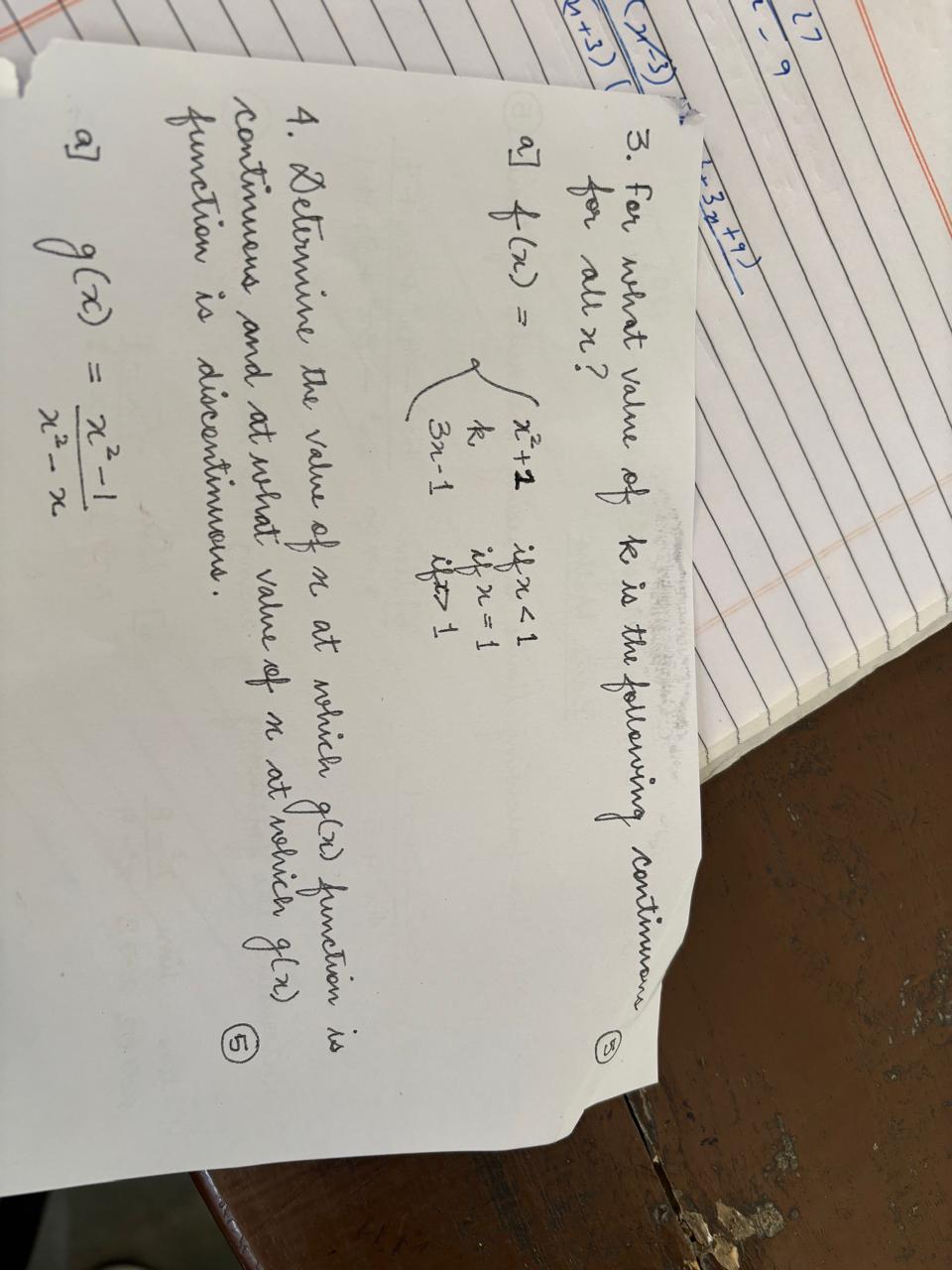For what value of k is the following continuous for all x? f(x) = { x + 2 if x < 3, k if x = 3, 3x - 1 if x > 3. Determine the value of n at which g(x) is continuous and at what va... For what value of k is the following continuous for all x? f(x) = { x + 2 if x < 3, k if x = 3, 3x - 1 if x > 3. Determine the value of n at which g(x) is continuous and at what value of n g(x) is discontinuous.

Understand the Problem
The question is asking to determine the values for the variable 'k' such that the function is continuous for all values of 'x'. It also asks to find the value of 'n' at which the function 'g(x)' is discontinuous, indicating a focus on the continuity and discontinuity of piecewise functions.
Answer
$k$ is indeterminate; $g(x)$ is continuous for all $n$ except $n = 0$ and $n = 1$.
Answer for screen readers
The function ( f(x) ) is discontinuous for any value of ( k ) since the limits are not equal. The function ( g(x) ) is continuous for all ( x ) except at ( n = 0 ) and ( n = 1 ).
Steps to Solve
- Determine continuity at x = 3 for f(x)
To ensure ( f(x) ) is continuous at ( x = 3 ), we need the left-hand limit and right-hand limit at ( x = 3 ) to equal ( f(3) = k ).
- Calculate the left-hand limit as x approaches 3
The left-hand limit is given by the function when ( x < 3 ): $$ \lim_{x \to 3^-} f(x) = 3 + 2 = 5 $$
- Calculate the right-hand limit as x approaches 3
The right-hand limit is given by the function when ( x > 3 ): $$ \lim_{x \to 3^+} f(x) = 3(3) - 1 = 9 - 1 = 8 $$
- Set the limits equal to k
For ( f(x) ) to be continuous at ( x = 3 ): $$ k = \lim_{x \to 3^-} f(x) = 5 $$ So, we also require: $$ k = 8 \quad (from , right-hand, limit) $$
- Determine k
For ( f(x) ) to be continuous, we need both limits to equal ( k ), which is impossible here. Therefore, there is no such ( k ) that makes ( f(x) ) continuous for all ( x ).
- Analyze g(x) for continuity
The function ( g(x) = \frac{x^2 - 1}{x^2 - x} ) needs to be simplified to find the points of discontinuity. Factor the numerator and denominator: $$ g(x) = \frac{(x-1)(x+1)}{x(x-1)} $$
- Identify discontinuities by setting the denominator equal to zero
Discontinuity occurs when: $$ x(x-1) = 0 \implies x = 0 , or , x = 1 $$
So, ( g(x) ) is discontinuous at ( n = 0 ) and ( n = 1 ).
- Establish continuity points
The function ( g(x) ) is continuous at all other values except at ( n = 0 ) and ( n = 1 ).
The function ( f(x) ) is discontinuous for any value of ( k ) since the limits are not equal. The function ( g(x) ) is continuous for all ( x ) except at ( n = 0 ) and ( n = 1 ).
More Information
The piecewise function fails to be continuous at the point ( x = 3 ) due to a discrepancy between the left and right limits. For ( g(x) ), the denominator indicates that it will be undefined at ( x = 0 ) and ( x = 1 ), leading to discontinuities.
Tips
- Expecting that the values for ( k ) will equal the limits at ( x = 3 ) without checking if both left and right limits match.
- Not simplifying ( g(x) ) correctly, which may lead to incorrect identification of discontinuous points.
AI-generated content may contain errors. Please verify critical information